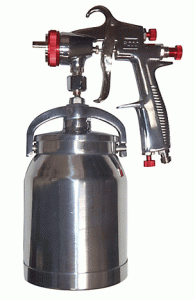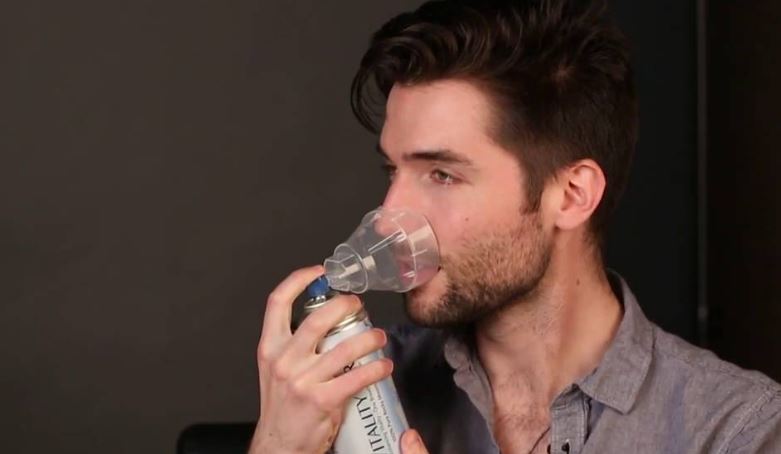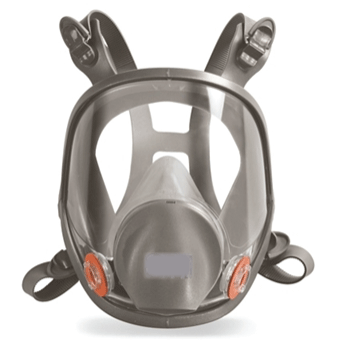Air from an air compressor is not for breathing. Do not breath air from an air compressor because this type of air is not suitable for human breathing unless you have sufficient and significant air treatment. Now there are also air compressors created specifically to produce breathing air. These industrial breathing air systems are created very specifically for this purpose. Read more below.
From time to time someone sends in a question about using compressed air for breathing air. They are asking about the air flow, what size of air tube or air line, or at what air pressure should they use to supply compressed air for breathing air.
And often, this question comes from folks that have a workshop air compressor, and want to be able to breathe other than paint fumes and paint while they spray paint something.
The short and simple answer is… DON’T!
If you don’t have an industrial breathing air system, then don’t breath that compressed air!
Why Should I Avoid Breathing Compressed Air?
Here’s why. Compressed air that is coming from an industrial or DIY type air compressor is not suitable for breathing.
Lubed-for-life air compressors have factory lubrication in the pump. Some of that gets into the air stream, into the tank, and into the air lines.
Air compressors that have added oil impart some of the oil to the air stream.
The intake filter on the compressor pump removes much of air borne debris, but it does not remove it all. That dust, of indeterminate origin, gets into the tank and into the air stream.
The inside-tank coating will deteriorate over time, and some of that, too, will get into the flow of air.
Air compressors generated water from the air as they compress air into the tank. That water mixes with all of the crud that is already in the tank, and some of that mixture gets into the air stream from the tank.
Any time a compressed air driven paint or chemical sprayer is used paint and chemicals are sprayed into the air and onto the work piece. Some of the atomized paint and chemicals will make its way to your mouth and nose, along with the compressed air that is driving it, and you will inhale it.
OSHA (Occupational Safety and Health Administration) confirms this, as stated on their website: “Hazardous breathing conditions exist in many routine industrial operations, such as chemical manufacturing, hospitals, abrasive blasting, paint spraying, industrial cleaning, and arc welding. In these and other operations that introduce contaminants into the workplace, supplied-air respirators, air filtration systems and carbon monoxide monitors are frequently used for worker protection.” (OSHA website)
Air Compressors That Produce Breathing Air
Now there are some air compressors that are created specifically to produce air for breathing. These are not industrial compressors and are created specifically for this purpose.

For example, scuba divers use air compressors. Air compressors are also used by firefighters, in coal mines, and for general safety in several industries. In such cases, the pressure is normally set between 200 and 300 bar.
Yeah, But Can I Breathe Air From My Industrial Compressor?
The answer is still no, UNLESS you add sufficient air-treatment equipment to an air line from an industrial air compressor that will prepare the air for breathing.
Some of the equipment necessary to clean compressed air to breathing quality includes – but is not limited to:
- general purpose 40 micron air filter (to remove larger particulates and free water)
- finer element 5 micron air filter (to filter finer particles from the air and further remove free water)
- air dryer (to remove water vapor)
- coalescent filter (to remove oil mist from the air)
You do want to make sure you prepare the air properly. A good source for information on what air preparation equipment is necessary to use compressed air for breathing air is the same OSHA website.
Note that this equipment only cleans the air coming from the compressor tank. It does not clean the sprayed paint that clouds the nozzle of the paint spray can or spray gun, and fills the room with aerosol paint. For that, you’ll need a breathing mask to accept cleaned air so that the person spraying paint can breathe clean air.
Otherwise, if you are contemplating breathing air from a mask that is being supplied by non-treated compressed air, you are risking your health, if not your life.
Here are a few breathing masks available on Amazon:
1.VILONG M04 Airsoft Tactical Protective Mask, Full Face Eye Protection Skull Dummy Game Mask with Dual Filter Fans Adjustable Strap for BB Gun CS Cosplay(Black)


2. OPARYY Full Seal Protection Rubber Respirator Eye Protection Respiratory Protection Widely Used in Paint Sprayer,A


3.AXH Anti-Fog Full Face Respirator Gas Mask Protection Respiratory Protection Widely Used,Box No. 7 Box 7 Piece Set

Using An Airtank For Breathing Air
Question: One question or two from me, onboard here we do a lot of tank work cleaning painting etc, and we use our firefighting Breething Apparatus for the air supply. These BA are to big for our workers working in enclosed places, do you have a suggestion that we can place some airtanks outside the area were we need to work and have some connection between the air supply outside the tank and connected to a breething device to our workers. In this way our workers can walk more freely inside.
________________________
We Answer…
Thanks for visiting about-air-compressors.com and for writing in.
I don’t doubt that you can get air tanks to feed a breathing mask for workers inside confined spaces. I do doubt that you would want to use a general purpose air compressor to fill those tanks.

If it were me, I’d be talking to the SCUBA people about high pressure air tanks for breathing. The compressors they use are able to pack an awful lot of air into a fairly small and portable single or double air tanks, can advise what type of air to use, and the regulators and masks you’ll need to use this air.
The air that’s compressed through the use of a general purpose air compressor will be full of moisture, perhaps compressor oil, and whatever particulates that the compressor intakes and sends along with the compressed air to the tank.
I understand the concern about the size of the BA you are using, but careful you don’t risk health for convenience.
Be careful, people. Compressed air is dangerous.
Folks, I just read an article that some industrial types were leak testing a pipeline with compressed air, and managed to blow up the pipe, damaged the building, actually moved a nearby car, and were fortunate that they didn’t kill themselves.
Using compressed air to pressure test a system or for leaks or for breathing is common, but can be dangerous. You need to use a precision regulator on the feed line into the pipe or vessel being tested, put a ball valve into a Tee, and then into the connection to the item being tested.
On the extra port on the Tee, install a precision gauge. Make sure the regulator is set very low, preferably 2-3 PSI at most, and flow air into the system through the ball valve until the precision gauge shows the test pressure. Close the ball valve to trap the air in the system. Over time, if there are no leaks, the gauge reading should be constant.
Force equals pressure times area. If the inside surface of your pipe or vessel, for example, has 1000 square inches of surface area, your 3 PSI of compresses air is trying to escape with a combined force of 3,000 lbs.!
Be careful.




